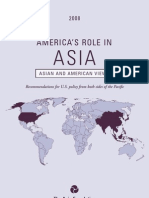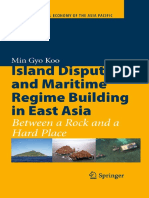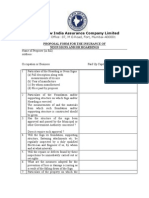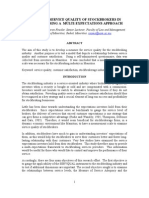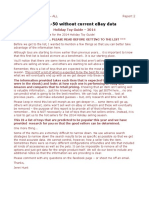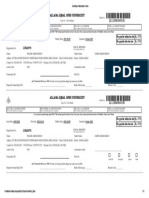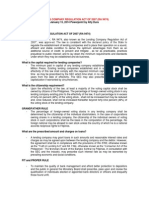Front Matter
Front Matter
Uploaded by
Narcis MarianCopyright:
Available Formats
Front Matter
Front Matter
Uploaded by
Narcis MarianCopyright
Available Formats
Share this document
Did you find this document useful?
Is this content inappropriate?
Copyright:
Available Formats
Front Matter
Front Matter
Uploaded by
Narcis MarianCopyright:
Available Formats
The Political Economy of the Asia Pacic
Series Editor Vinod K. Aggarwal
For other titles published in this series; go to http://www.springer.com/series/7840
Vinod K. Aggarwal Seungjoo Lee
Editors
Trade Policy in the Asia-Pacic
The Role of Ideas, Interests, and Domestic Institutions
Editors Vinod K. Aggarwal Department of Political Science University of California Berkeley, CA USA vinod@berkeley.edu
Seungjoo Lee Department of Political Science Chung-Ang University, Seoul South Korea seungjoo@cau.ac.kr
ISSN 1866-6507 e-ISSN 1866-6515 ISBN 978-1-4419-6832-6 e-ISBN 978-1-4419-6833-3 DOI 10.1007/978-1-4419-6833-3 Springer New York Dordrecht Heidelberg London Library of Congress Control Number: 2010938432
# Springer Science+Business Media, LLC 2011 All rights reserved. This work may not be translated or copied in whole or in part without the written permission of the publisher (Springer Science+Business Media, LLC, 233 Spring Street, New York, NY 10013, USA), except for brief excerpts in connection with reviews or scholarly analysis. Use in connection with any form of information storage and retrieval, electronic adaptation, computer software, or by similar or dissimilar methodology now known or hereafter developed is forbidden. The use in this publication of trade names, trademarks, service marks, and similar terms, even if they are not identied as such, is not to be taken as an expression of opinion as to whether or not they are subject to proprietary rights. Printed on acid-free paper Springer is part of Springer ScienceBusiness Media (www.springer.com)
Preface
The trade institutional landscape in the Asia-Pacic is in rapid ux. Countries in the transpacic region have been pursuing a web of bilateral and minilateral trade agreements. Controversy over which institutional conguration is best suited for the region has reached a high pitch, with leaders formulating new congurations on a regular basis. These ideas for new institutions come in the context of an already crowded eld of arrangements and a moribund World Trade Organization (WTO). These include the ASEAN Free Trade Agreement (AFTA), the ASEAN + 3 (including Japan, China, and South Korea) discussions, the East Asia Summit (EAS), which include these three plus India, Australia, and New Zealand, and APEC, with its 21 member economies (with Taiwan and Hong Kong, hence the term economies). More recently, we have seen a proliferation of bilateral free trade (or preferential, depending on ones degree of cynicism) agreements. New efforts to bring some semblance of order to the potpourri of trade accords include the Trans-Pacic Strategic Economic Partnership (TPP), which would link existing and create new bilateral trade agreements among Asia-Pacic countries. Ironically, in the 1980s, analysts expressed concern over the lack of institutional arrangements to manage economic relations in Asia. Although trade in Asia had grown rapidly with the networking role of Japanese rms and Chinese ethnic groups, some expressed concerns about the lack of formalized institutions. With the end of the Cold War, the Asian nancial crisis, rising Sino-Japanese rivalry, and now the global nancial crisis, scholars have often focused on these shocks as driving the institutional transformation of the Asia-Pacic. Yet this research on the East Asian region and the Asia-Pacic region more generally tends to be statecentric, focusing on characterizing actors national interests, but without paying adequate attention to key subnational players. Although shocks and systemic changes are undoubtedly crucial catalysts in accounting for the newfound rush to bilateral and minilateral efforts, these explanations fall short of fully capturing the crucial differences in national responses to common external shocks. This book attempts to address this lacuna in the examination of different types of East Asian trade policies and American strategies through the careful characterization of types of accords and then the development of a systematic domestic
v
vi
Preface
bargaining game approach focusing on idea, interests, and institutions to account for different types of arrangements. It is our claim that a focus on the interplay of these three driving forces can provide much deeper insight into the trajectory of trade institutions in the Asia-Pacic than a state-centric, billiard ball approach. The Kim Dae-jung Presidential Library, Yonsei University, was instrumental in bringing this effort to fruition. The foundations nancial generosity is much appreciated. Its support allowed us to host two major conferences at the University of California at Berkeley. These meetings and opportunities for interaction have greatly strengthened our work and also helped to build enduring ties among scholars that geographically span more than half the globe. At our rst meeting in Berkeley in December 2007, the participants beneted from the insightful comments of Alexsia Chan, Crystal Chang, Kristi Govella, Rongbin Han, Joon Seok Hong, Kenji Kushida, and Sara Newland. Based on their valuable suggestions, authors revised their papers and we held a second meeting in December 2008 at Berkeley. At this conference, we received comments from Kristi Govella, Kenji Kushida, Sara Newland, Seo-Hyun Park, and Darren Zook. The work of the Berkeley APEC Study Center staff proved crucial. Without the leadership of Project Director Kristi Govella, this book would never have seen the light of day. She provided insightful comments to the chapter authors and helped to manage the publication process. In these tasks, a number of undergraduates, who for the most part have worked or currently work at BASC as part of the Berkeley Undergraduate Research Apprenticeship program, also helped. For their work in managing the Berkeley conferences, we are particularly grateful to Bao Kham Chau, Robert Chen, Cindy Cheng, Ross Cheriton, Nathan DeRemer, Michelle Haq, Cindy Hwang, Vaishnavi Jayakumar, Andrew Kim, Anne Meng, and Aroon Vijaykar. In preparing the manuscript, we greatly beneted from the editing work of Kathy Bowen, Michelle Chang, Ren Yi Hooi, Robert Nelson, and Peter Volberding. We are indebted to the Ron and Stacy Guteish Foundation for their generous annual contributions to support BASCs work. Finally, we would like to thank Jon Gurstelle of Springer Verlag for his help and support. We, of course, remain responsible for any errors or omissions.
Contents
The Domestic Political Economy of Preferential Trade Agreements in the Asia-Pacic . . . . . . . . . . . . . . . . . . . . . . . . . . . . . . . . . . . . . . . . . Vinod K. Aggarwal and Seungjoo Lee The Domestic Political Economy of Chinas Preferential Trade Agreements . . . . . . . . . . . . . . . . . . . . . . . . . . . . . . . . . . . . . . . . . . . . . . . . . . . . . . . Ming Wan The Domestic Politics of Japans Regional Foreign Economic Policies . . . . . . . . . . . . . . . . . . . . . . . . . . . . . . . . . . . . . . . . . . . . . . . . . . . . . . . . Ellis S. Krauss and Megumi Naoi South Koreas Political Dynamics of Regionalism: A Comparative Study of KoreaJapan FTA and KoreaU.S. FTA . Sang-young Rhyu The United States and Asian Regionalism: The Politics of Reactive Leadership . . . . . . . . . . . . . . . . . . . . . . . . . . . . . . . . . . . . . . . . . . . . . . . . . . Amy Searight The Politics of Singapores Bilateral Free Trade Agreements: Enlightened Self-interest to Promote East Asian Regionalism in the New Millennium?. . . . . . . . . . . . . . . . . . . . . . . . . . . . . . . . . . . . . . . . . . . . . . . . . Lee Lai To and Ren Yi Hooi Evolving Trade Strategies in the Asia-Pacic . . . . . . . . . . . . . . . . . . . . . . . . . Vinod K. Aggarwal and Seungjoo Lee
29
49
71
89
121
143
Index. . . . . . . . . . . . . . . . . . . . . . . . . . . . . . . . . . . . . . . . . . . . . . . . . . . . . . . . . . . . . . . . . . . . . . . . . .
155
vii
Contributors
Vinod K. Aggarwal is Professor of Political Science, Afliated Professor in Business and Public Policy at the Haas School of Business, and Director of the Berkeley APEC Study Center at the University of California at Berkeley. Ren Yi Hooi is an undergraduate majoring in economics and a research assistant at the Berkeley APEC Study Center, University of California at Berkeley. Ellis S. Krauss is Professor of Japanese Politics and Policymaking at the Graduate School of International Relations and Pacic Studies at the University of California, San Diego. Lee Lai To is Associate Professor at the Department of Political Science at the National University of Singapore. Seungjoo Lee is Associate Professor in the Department of Political Science at Chung-Ang University. Megumi Naoi is an Assistant Professor in the Department of Political Science at the University of California at San Diego. Sang-young Rhyu is an Associate Professor in the Graduate School of International Studies at Yonsei University and formerly served as Director of the Kim Dae-jung Presidential Library and Museum, Yonsei University. Amy Searight is an Adjunct Fellow at the Center for Strategic and International Studies in Washington, DC, and Adjunct Professor at the Elliott School of International Affairs at George Washington University. Ming Wan is a Director of the Global Affairs Program and Professor of Government and Politics at George Mason University.
ix
Abbreviations
ACFTA AFTA AMF APEC ARF ASEAN ASEM BTA CAFTA CEPEA CER DDR DPJ DRC EAEC EAS EASG EAVG EFTA EU EVSL FDI FSA FTA FTAAP GATT GCC
ASEAN-China Free Trade Area ASEAN Free Trade Area Asian Monetary Fund Asia Pacic Economic Cooperation ASEAN Regional Forum Association of Southeast Asian Nations Asia-Europe Meeting Basic Telecom Agreement China ASEAN Free Trade Agreement Comprehensive Economic Partnership in East Asia Closer Economic Relations Doha Development Round Democratic Party of Japan Development Research Center East Asian Economic Caucus East Asia Summit East Asia Study Group East Asia Vision Group European Free Trade Area European Union Early Voluntary Sector Liberalization Foreign Direct Investment Financial Services Agreement Free Trade Agreement Free Trade Area of the Asia Pacic General Agreement on Tariffs and Trade Gulf Cooperation Council
xi
xii
Abbreviations
IMF ITA KORUS LDP MAFF METI MITI MMM MOFA MTI NAFTA NATO OECD PAFTA PAFTAD PBEC PECC PR PTA SACU SMD SNTV TAC TPP USTR VER WTO
International Monetary Fund Information Technology Agreement United States-South Korea Free Trade Agreement Liberal Democratic Party Ministry of Agriculture, Forestry and Fisheries Ministry of Economics, Trade, and Industry Ministry of International Trade and Industry Mixed Member Majoritarian Ministry of Foreign Affairs Ministry of Trade and Industry North American Free Trade Agreement North Atlantic Treaty Organization Organization for Economic Co-operation and Development Pacic Free Trade Area Pacic Trade and Development Forum Pacic Basin Economic Council Pacic Economic Cooperation Council Proportional Representation Preferential Trading Agreements South Africa Customs Union Single Member District Single Non-Transferable Vote Treaty of Amity and Cooperation Trans-Pacic Strategic Economic Partnership US Trade Representative Voluntary Export Restraint World Trade Organization
You might also like
- The Evolution of Economic Ideas and Systems PDFDocument207 pagesThe Evolution of Economic Ideas and Systems PDFFrancis Gabriel Abog100% (1)
- Jiali Zhou, Guobin Zhang - A Study of Diplomatic Protocol and Etiquette - From Theory To Practice (2022, Springer) - Libgen - LiDocument274 pagesJiali Zhou, Guobin Zhang - A Study of Diplomatic Protocol and Etiquette - From Theory To Practice (2022, Springer) - Libgen - LiCsaba Attila Both100% (3)
- Eugene Silberberg PDFDocument2 pagesEugene Silberberg PDFStephenNo ratings yet
- Populism, Nationalism and South China Sea Dispute Chinese and Southeast AsianDocument164 pagesPopulism, Nationalism and South China Sea Dispute Chinese and Southeast AsianSovanrangsey Kong100% (5)
- Corruption The Boom and Bust of EastAsiaDocument116 pagesCorruption The Boom and Bust of EastAsiaALBERTO GONo ratings yet
- Law On ParCor - Chap1Document10 pagesLaw On ParCor - Chap1Christel ToledoNo ratings yet
- (Saori N. Katada, Mireya Solis, Eds.) Cross RegionDocument173 pages(Saori N. Katada, Mireya Solis, Eds.) Cross RegionadityarahmanfadNo ratings yet
- On Korea 2013 Volume 6 Complete Full Version FinalDocument184 pagesOn Korea 2013 Volume 6 Complete Full Version FinalKorea Economic Institute of America (KEI)100% (2)
- Americas Role in Asia 2008Document321 pagesAmericas Role in Asia 2008Abdul NaeemNo ratings yet
- 0503q FULL PDFDocument169 pages0503q FULL PDFPaduka Soria RamliNo ratings yet
- Joint U.S.-Korea Academic StudiesDocument264 pagesJoint U.S.-Korea Academic StudiesKorea Economic Institute of America (KEI)No ratings yet
- The Future of The Korea-Japan Strategic Relationship: A Case For Cautious Optimism by Park Cheol-HeeDocument21 pagesThe Future of The Korea-Japan Strategic Relationship: A Case For Cautious Optimism by Park Cheol-HeeKorea Economic Institute of America (KEI)No ratings yet
- Kei Onkorea 2014 Final Single PagesDocument142 pagesKei Onkorea 2014 Final Single PagesKorea Economic Institute of America (KEI)No ratings yet
- ASEAN Indo-Pacific Strategy and US-China RivalryDocument105 pagesASEAN Indo-Pacific Strategy and US-China RivalrySok Udom Deth100% (1)
- The Japan--South Korea Identity Clash: East Asian Security and the United StatesFrom EverandThe Japan--South Korea Identity Clash: East Asian Security and the United StatesNo ratings yet
- Asia's New Multilateralism: Cooperation, Competition, and the Search for CommunityFrom EverandAsia's New Multilateralism: Cooperation, Competition, and the Search for CommunityNo ratings yet
- Where Can Buy Asian Yearbook of International Law Volume 23 2017 Volume 23 2017 1st Edition Seokwoo Lee Ebook With Cheap PriceDocument84 pagesWhere Can Buy Asian Yearbook of International Law Volume 23 2017 Volume 23 2017 1st Edition Seokwoo Lee Ebook With Cheap Pricekotchloata100% (5)
- China's International Relations in the 21st Century: Dynamics of Paradigm ShiftsFrom EverandChina's International Relations in the 21st Century: Dynamics of Paradigm ShiftsNo ratings yet
- ComparativeConnections Vol24 No3Document202 pagesComparativeConnections Vol24 No3nurhalisatamaraNo ratings yet
- Asian Yearbook of International Law Volume 23 2017 Volume 23 2017 1st Edition Seokwoo Lee all chapter instant downloadDocument55 pagesAsian Yearbook of International Law Volume 23 2017 Volume 23 2017 1st Edition Seokwoo Lee all chapter instant downloadchiwozumrNo ratings yet
- (Min Gyo Koo (Auth.) ) Island Disputes and Maritime (B-Ok - Xyz)Document217 pages(Min Gyo Koo (Auth.) ) Island Disputes and Maritime (B-Ok - Xyz)gootNo ratings yet
- Shinzo Abe s Indo-Pacific Strategy Japan s Recent Achievement and Future DirectionDocument23 pagesShinzo Abe s Indo-Pacific Strategy Japan s Recent Achievement and Future DirectionAdriano CampelloNo ratings yet
- Book ReviewDocument5 pagesBook ReviewAneesh AnandNo ratings yet
- The Great Wall of Money: Power and Politics in China's International Monetary RelationsFrom EverandThe Great Wall of Money: Power and Politics in China's International Monetary RelationsNo ratings yet
- Engaging and Transforming North Korea's Economy, by William B. BrownDocument28 pagesEngaging and Transforming North Korea's Economy, by William B. BrownKorea Economic Institute of America (KEI)100% (1)
- Decoding The Rise of China Taiwanese and Japanese Perspectives by Tse-Kang Leng, Rumi Aoyama PDFDocument184 pagesDecoding The Rise of China Taiwanese and Japanese Perspectives by Tse-Kang Leng, Rumi Aoyama PDFMarcinNo ratings yet
- Singh (2022) - BOOK REVIEW - The Courteous Power - Japan and Southeast Asia in The Indo-Pacific. Edited by John D. Ciorciari and Kiyoteru TsutsuiDocument3 pagesSingh (2022) - BOOK REVIEW - The Courteous Power - Japan and Southeast Asia in The Indo-Pacific. Edited by John D. Ciorciari and Kiyoteru TsutsuiLisye Katrina LumbantobingNo ratings yet
- SVI Foresight Vol 10 Issue 07 July 2024Document31 pagesSVI Foresight Vol 10 Issue 07 July 2024afzaal011No ratings yet
- Between Ally and Partner: Korea-China Relations and the United StatesFrom EverandBetween Ally and Partner: Korea-China Relations and the United StatesNo ratings yet
- Download The Future of East Asia 1st Edition Peter Hayes ebook All Chapters PDFDocument55 pagesDownload The Future of East Asia 1st Edition Peter Hayes ebook All Chapters PDFreottkyranme100% (2)
- Korea China Relations in History and Contemporary ImplicationsDocument230 pagesKorea China Relations in History and Contemporary ImplicationsIdo Shtern100% (1)
- 0330 China LieberthalDocument65 pages0330 China Lieberthallhg900No ratings yet
- Strategic Distrust - US and ChinaDocument65 pagesStrategic Distrust - US and ChinaAbhishek AmarNo ratings yet
- Asian Rivalries: Conflict, Escalation, and Limitations on Two-level GamesFrom EverandAsian Rivalries: Conflict, Escalation, and Limitations on Two-level GamesNo ratings yet
- (Understanding China) Silvio Beretta, Axel Berkofsky, Lihong Zhang (Eds.)-Understanding China Today_ an Exploration of Politics, Economics, Society, And International Relations-Springer InternationalDocument355 pages(Understanding China) Silvio Beretta, Axel Berkofsky, Lihong Zhang (Eds.)-Understanding China Today_ an Exploration of Politics, Economics, Society, And International Relations-Springer InternationalJuan Pablo100% (2)
- Quarterly: The Challenge of ChinaDocument36 pagesQuarterly: The Challenge of ChinaNham HoaNo ratings yet
- 2017 Book China-EURelations PDFDocument256 pages2017 Book China-EURelations PDFVale Espinel BurgosNo ratings yet
- Japan's Democracy DiplomacyDocument42 pagesJapan's Democracy DiplomacyGerman Marshall Fund of the United States100% (1)
- Term Paper International RelationsDocument7 pagesTerm Paper International Relationsfuhukuheseg2100% (1)
- One Belt One Road - Implications On Singapore & Sino-Singapore RelationsDocument10 pagesOne Belt One Road - Implications On Singapore & Sino-Singapore Relationsleong_jiaqianNo ratings yet
- PDF The Future of East Asia 1st Edition Peter Hayes DownloadDocument52 pagesPDF The Future of East Asia 1st Edition Peter Hayes Downloadtarmiztaedza100% (4)
- Higgott 1994Document21 pagesHiggott 1994Boris MarkovićNo ratings yet
- Ethnic Armed Conflict and Territorial Administration in MyanmarDocument120 pagesEthnic Armed Conflict and Territorial Administration in MyanmarMi Hnin Myat LwinNo ratings yet
- Zhang Baohui (2010) 254-255-1-PBDocument32 pagesZhang Baohui (2010) 254-255-1-PBshizogulaschNo ratings yet
- Get Prospect Theory and Foreign Policy Analysis in the Asia Pacific Rational Leaders and Risky Behavior 1st Edition Kai He PDF ebook with Full Chapters NowDocument55 pagesGet Prospect Theory and Foreign Policy Analysis in the Asia Pacific Rational Leaders and Risky Behavior 1st Edition Kai He PDF ebook with Full Chapters NowgalszentNo ratings yet
- Beyond the Middle Kingdom: Comparative Perspectives on China’s Capitalist TransformationFrom EverandBeyond the Middle Kingdom: Comparative Perspectives on China’s Capitalist TransformationScott KennedyNo ratings yet
- Introduction To Ideas of Asian RegionalismDocument14 pagesIntroduction To Ideas of Asian RegionalismJD AmpayaNo ratings yet
- Burma/Myanmar: Outside Interests and Inside Challenges, Outside InterestsDocument234 pagesBurma/Myanmar: Outside Interests and Inside Challenges, Outside Interestsrohingyablogger100% (1)
- Chinese Dissertation TopicsDocument4 pagesChinese Dissertation TopicsWriteMyCollegePaperUK100% (1)
- The Supply Side of Security: A Market Theory of Military AlliancesFrom EverandThe Supply Side of Security: A Market Theory of Military AlliancesNo ratings yet
- East Asians in The League of Nations: Actors, Empires and Regions in Early Global Politics Christopher R. Hughes Download PDFDocument47 pagesEast Asians in The League of Nations: Actors, Empires and Regions in Early Global Politics Christopher R. Hughes Download PDFzeritujiyoon4No ratings yet
- 2016 Program Book 29 Nov 2016 For WebsiteDocument20 pages2016 Program Book 29 Nov 2016 For Websitemahendra singhNo ratings yet
- Strategic Coupling: East Asian Industrial Transformation in the New Global EconomyFrom EverandStrategic Coupling: East Asian Industrial Transformation in the New Global EconomyNo ratings yet
- Full Download Japan and Asia's Contested Order: The Interplay of Security, Economics, and Identity Yul Sohn PDFDocument62 pagesFull Download Japan and Asia's Contested Order: The Interplay of Security, Economics, and Identity Yul Sohn PDFaghyadmezhda100% (2)
- Instant Access To Perspectives On International Relations Power Institutions and Ideas Henry R. Nau Ebook Full ChaptersDocument62 pagesInstant Access To Perspectives On International Relations Power Institutions and Ideas Henry R. Nau Ebook Full Chaptersnanapohrbata100% (3)
- Great Power Rivalry and Southeast Asian Agency Southeast Asia in An Era of US-China Strategic CompetitionDocument15 pagesGreat Power Rivalry and Southeast Asian Agency Southeast Asia in An Era of US-China Strategic Competitionhasbullah368No ratings yet
- BLDocument1 pageBLFreddy Javier Martínez Ocón67% (3)
- Membership and Uploading - CICsDocument1 pageMembership and Uploading - CICstreddy249No ratings yet
- Chemical Companies IsraelDocument9 pagesChemical Companies Israelmarketing lakshNo ratings yet
- A-QSF-Borang Soal Selidik Profil Usahawan FEB 2019Document5 pagesA-QSF-Borang Soal Selidik Profil Usahawan FEB 2019TongNo ratings yet
- KuppuswamyDocument2 pagesKuppuswamyAstha SharmaNo ratings yet
- Presensation On Analysis of NTPC by Mckinsey's 7-sDocument9 pagesPresensation On Analysis of NTPC by Mckinsey's 7-sSatinder Rai BansalNo ratings yet
- Greetings From BNSM Holiday TripsDocument4 pagesGreetings From BNSM Holiday TripsKrishnaNo ratings yet
- Beethoven Virus Ost - Passion (Piano)Document5 pagesBeethoven Virus Ost - Passion (Piano)twylaNo ratings yet
- Minimalist Slides For Meeting - by SlidesgoDocument50 pagesMinimalist Slides For Meeting - by SlidesgocoelhofrancesscaNo ratings yet
- Political and Economic Impacts of The Great DepressionDocument2 pagesPolitical and Economic Impacts of The Great Depressiongloriawaters31No ratings yet
- SOCI 100: Introduction To Sociology Instructor: Deniz Yükseker Koç University Spring 2013Document16 pagesSOCI 100: Introduction To Sociology Instructor: Deniz Yükseker Koç University Spring 2013Raquel disomimbaNo ratings yet
- Case Digest - FERRER v. DIAZ Et. AlDocument2 pagesCase Digest - FERRER v. DIAZ Et. AlMiguel Joshua Gange AguirreNo ratings yet
- Microsoft Dynamics 365 Cloud Service Compliance DatasheetDocument6 pagesMicrosoft Dynamics 365 Cloud Service Compliance DatasheetMartinNo ratings yet
- Origin Certificate For CPY-375Document1 pageOrigin Certificate For CPY-375AnandNo ratings yet
- 30 Harts Hill TrackDocument1 page30 Harts Hill Trackspaceship9No ratings yet
- Money Management SheetDocument59 pagesMoney Management SheetU ADEEGIDA BULSHADANo ratings yet
- Proposal Form For The Insurance of Neon Signs And/or HoardingsDocument3 pagesProposal Form For The Insurance of Neon Signs And/or Hoardingsm_dattaiasNo ratings yet
- A Study of Service Quality of Stockbrokers in Mauritius UsingDocument12 pagesA Study of Service Quality of Stockbrokers in Mauritius Usingpoison jenNo ratings yet
- Items 1-50 Without Current Ebay Data: 2014 Holiday Toy Guide - All Report 2Document14 pagesItems 1-50 Without Current Ebay Data: 2014 Holiday Toy Guide - All Report 2markfoyNo ratings yet
- Continue Admission FormDocument1 pageContinue Admission FormWaqar Akbar KhanNo ratings yet
- Transfer PricingDocument5 pagesTransfer PricingLordz OcarizaNo ratings yet
- Board Fence ProjectDocument12 pagesBoard Fence ProjectIzzahNo ratings yet
- Behavior of Imperfect CompetitorsDocument3 pagesBehavior of Imperfect CompetitorsMohammad Rizal GhozaliNo ratings yet
- History of Hongkong and Shanghai Banking Corporation LimitedDocument35 pagesHistory of Hongkong and Shanghai Banking Corporation LimitedMonir HosenNo ratings yet
- Micro-Economic Analysis of Nestle Ma Assignment: Group 2IDocument7 pagesMicro-Economic Analysis of Nestle Ma Assignment: Group 2IShreya GhoshNo ratings yet
- Lending Company Regulation Act of 2007Document1 pageLending Company Regulation Act of 2007jade123_129No ratings yet
- Sample Project ProposalDocument13 pagesSample Project ProposalHezekiah AntonanoNo ratings yet








